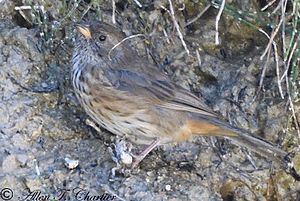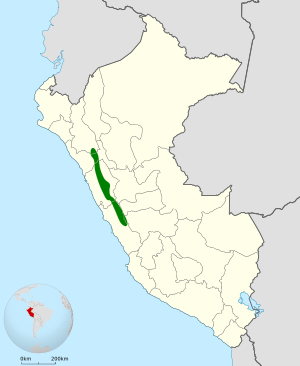Rufous-breasted warbling finch facts for kids
Quick facts for kids Rufous-breasted warbling finch |
|
|---|---|
 |
|
| A Rufous-breasted Warbling Finch in Department of Lima, Peru | |
| Conservation status | |
| Scientific classification | |
| Genus: |
Poospiza
|
| Species: |
rubecula
|
 |
|
The rufous-breasted warbling finch (Poospiza rubecula) is a small bird that lives only in Peru. It belongs to the Thraupidae family, which includes many types of finches and tanagers. This special bird is known for its reddish-brown chest and its beautiful song.
Sadly, the rufous-breasted warbling finch is an endemic species, meaning it is found nowhere else in the world. It is currently listed as an endangered species. This means its numbers are very low, and it is at high risk of disappearing forever.
Contents
About the Rufous-breasted Warbling Finch
The rufous-breasted warbling finch was first described in 1895 by a scientist named Osbert Salvin. It is a type of finch, which are small birds known for their strong, cone-shaped beaks. These beaks are perfect for cracking open seeds.
What Does It Look Like?
As its name suggests, this finch has a noticeable reddish-brown (rufous) color on its chest. The rest of its feathers might be different shades of gray or brown, helping it blend into its surroundings. Like other finches, it is a relatively small bird.
Where Does It Live?
This finch lives in specific parts of Peru. Its natural habitats include dry forests in subtropical areas. Subtropical means regions that are just outside the tropical zones, usually having warm climates.
It also lives in high-altitude shrubland. Shrubland is an area covered mainly by shrubs and bushes, rather than tall trees. These high-up places in the Andes mountains provide the right environment for the finch to find food and build its nests.
Why Is It Endangered?
The main reason the rufous-breasted warbling finch is in danger is habitat loss. This means that the places where it naturally lives are being destroyed or changed.
Causes of Habitat Loss
People might clear forests for farming, build new towns, or use the land for other purposes. When this happens, the finches lose their homes, their food sources, and safe places to raise their young. This makes it very hard for their populations to grow.
Conservation Efforts
Protecting the rufous-breasted warbling finch means protecting its habitat. Conservation groups and scientists are working to save these important areas. They hope to ensure that this unique Peruvian bird can survive and thrive for many years to come.
See also
 In Spanish: Monterita pechirrufa para niños
In Spanish: Monterita pechirrufa para niños


